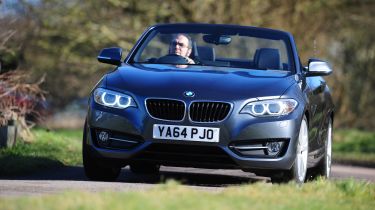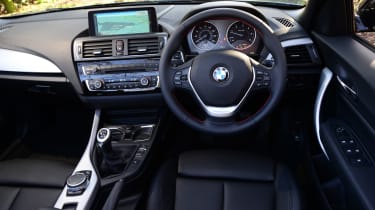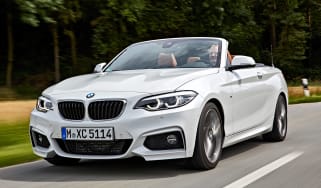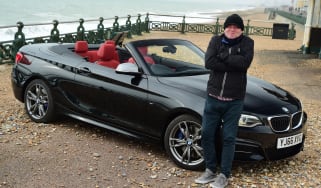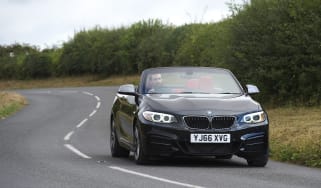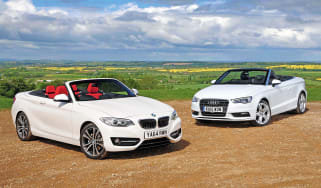BMW 2 Series Convertible (2015-2021) review
BMW 2 Series convertible replaced the old 1 Series soft-top with more pace, efficiency and style

This is a review of a new 2015-2021 2 Series Convertible. If you are interested in information about the latest BMW 2 Series please follow the links provided.
If you're after a small four-seater convertible, you can't go far wrong with the BMW 2 Series. It looks good, has a strong range of engines and is nearly as fun to drive as the coupe model it's based on. It's pricey, but so are all of its rivals – this is a class of car where buyers are happy to shell out that bit extra to get that luxury of the folding roof.
Style is a very important factor in the compact cabriolet sector, and the BMW 2 Series Convertible is among the most desirable models on sale. A selection of mid-life updates in 2017 made it a stronger rival than ever for the Audi A3 Cabriolet, too.
This new-found sense of style doesn’t detract from the driving experience, though, as the 2 Series Convertible is still great fun to drive. There’s bags of grip on offer, plenty of feedback from the chassis and a reasonably comfortable ride that makes it an impressive all-rounder.
Petrol engines range from the basic three-cylinder 218i, through the four-cylinder 220i and 230i, up to the flagship M240i. The diesel line-up is almost as extensive, with a 218d and 220d on offer. All offer reasonable running costs (aside from the M240i), while most of the higher-spec engines get a slick-shifting auto box as standard. While xDrive all-wheel drive is available on the Coupe, it's not even an option on the Convertible.
Used - available now

2024 Volkswagen
Polo
26,127 milesAutomaticPetrol1.0L
Cash £17,375
2022 Peugeot
308 SW
45,289 milesAutomaticPetrol1.2L
Cash £16,025
2024 Peugeot
2008
14,766 milesAutomaticPetrol1.2L
Cash £17,025
2024 Toyota
Aygo X
26,564 milesAutomaticPetrol1.0L
Cash £13,350Rivals include everything from the Audi A3 Convertible, through to the Porsche 718 Boxster and Mercedes C-Class Cabriolet. Buyers might also be interested in the two-seat Audi TT Roadster.
To improve the 2 Series Convertible’s handling over its 1 Series predecessor, BMW added extra strengthening. As a result, the body shell is around 20 per cent stiffer than before, meaning body wobble is kept to a minimum, again aiding performance and refinement.
Practicality isn’t too bad for a small convertible, with a good sized boot and two small rear seats to offer extra space. Most of the interior is carried over from the 2 Series Coupe, in fact, meaning the Convertible is a comfortable cruiser, helped by a new triple-layer insulated roof that keeps road noise to a minimum.
There are six engines to choose from, ranging from a entry-level three-cylinder to the range topping diesels and hot M240i. The mid-spec 220d is an excellent choice though, offering plenty of pace (matching the similarly-priced 220i petrol), but returning up to 47.1mpg.
Beware the quick-sounding 230i, however, as it actually uses the same turbocharged 2.0-litre engine (albeit with more power) as the 220i, yet is barely any faster. There are SE, Sport and M-Sport trim levels available, with the most expensive models adding even more style with bigger wheels and a sporty body kit.
Engines, performance and drive
BMWs have always been decent drivers’ cars, with good weight distribution thanks to their front-engine, rear-wheel-drive layout. The lovely balance this set-up brings is still ingrained in the 2 Series Convertible, but it’s not quite as composed as its coupé cousin.
Removing the roof for a cabriolet reduces the car’s structural rigidity, and even though the 2 Series is 20 per cent stiffer than the model it replaces, driving along smooth roads its chassis wobbles and fidgets around, with noticeable vibrations fed back through the steering column.
Big bumps knock the chassis off-line, too, and you have to guide the wheel with a firm hand to keep the 2 Series on course on anything other than a perfect surface.
This is even with the optional adjustable suspension dampers linked to BMW’s Drive Performance Control system set to Comfort, although the ride has a nice soft edge and feels controlled. But again, only on super-smooth roads.
However, despite this dynamic downside there is still lots of grip on offer. The BMW’s steering is light – even in the Sport setting – but it’s not devoid of feel, so you can gauge what the front and rear wheels are doing.
The 2 Series Convertible serves up nicely balanced handling, allowing you to adjust the car’s cornering line with the accelerator and steering. However, the 1 Series underpinnings are obvious, and the soft-top 2 Series feels more like a modified hatchback to drive than an out-and-out sports car.
Engines
There's a wide range of engines on offer, meaning there should be something to suit all preferences. The petrol line-up now starts with the three-cylinder 218i, moving up through the four-cylinder 220i and 230i, through to the top-spec M240i, which uses a six-cylinder unit with 335bhp. It's a superb engine, with a great soundtrack and smooth power delivery.
If you're after a diesel (and a lot of buyers still are) there's an entry-level 218d with 148bhp, which offers decent performance and good fuel economy. The 220d diesel represents the best compromise, however, as with 187bhp and 400Nm of torque it has plenty of performance and is very nearly as efficient.
MPG, CO2 and Running Costs
The 2 Series Cabrio isn’t a cheap car to buy, with prices starting from around £27,500 for the entry-level 218i SE model and rising to nearly £40,000 for the range-topping M240i. However, running costs shouldn’t be too much of a problem.
Even the high-performance M240i claims an average of 34mpg – pretty impressive in a car that will get from 0-62mph in 5.0 seconds. The diesel claims over 60mpg, with low CO2 figures of 118g/km for the automatic, making it a tempting company car choice.
Private buyers should always take advantage of BMW’s pre-paid annual servicing packs when they buy their cars – it makes servicing at BMW main dealers much more affordable.
Insurance groups
Despite being a convertible, choosing the 2 Series drop-top shouldn't make much difference to your insurance premiums. Ratings start at group 21 for the 218i (just one group higher than the Coupe), and top out at group 32 for a 225d. An M240i will cost more, naturally.
Depreciation
The BMW 2 Series fares pretty well when it comes to depreciation, holding on to as much as 52 per cent of its value after three years or 30,000 miles. The 220d M Sport is the most desirable model on the second-hand market, while 220i buyers will lose the most money when the time comes to sell.
To get an accurate valuation on a specific model check out our free car valuation tool...
Interior, design and technology
Compared with the gawky-looking 1 Series, the BMW 2 Series is a much more elegant machine – and this Convertible carries over the coupe's long, low lines. As a result, the BMW looks great with its roof up or down.
Some modern convertibles use folding hard-tops, but BMW has stuck with a fabric roof for the 2 Series Convertible, which owners can spec in different colours which add a sense of style alongside the gloss-black body accents on some models.
At the front, the long bonnet stretches forward with BMW’s famous kidney grille taking pride of place in the heavily styled bumper. The 2 Series’ striking headlights also help give the car an aggressive scowl. It was updated in 2017 with new lights, a redesigned bumper and a slightly wider grille. The external changes are minimal, but they give the 2 a fresh look.
BMW’s familiar L-shaped tail-lights make an appearance at the rear, but they eat into the boot aperture, reducing practicality. Some models get dark chrome twin tailpipes as standard to add to the racier look, while larger wheels are an optional add-on. Overall, it’s a very attractive design that looks chic and graceful with a focused edge.
Sat-nav, stereo and infotainment
The 2 Series’ cockpit will be familiar to most BMW owners, borrowing its dash design and layout from the Coupé and 1 Series hatchback. That’s no bad thing, as with its iDrive controller and upgraded 8.8-inch sat-nav screen the infotainment system is still one of the slickest around.
All cars were facelifted in 2017 to bring the car up-to-date with other models in the BMW range. The 2 Series inherited much of the tech first found on the 5 Series saloon, and is all the better for it. Digital dials, Apple CarPlay and a touchscreen display bring the car into the 21st century – giving the interior a much more modern feel. However, compared to the Audi A3’s minimalist, high-quality cabin, the BMW is showing its age.
Practicality, comfort and boot space
Although there’s plenty of room for the driver, plus good seat and steering adjustment to get a great driving position, rear passengers get a raw deal. With the rear seats shuffled forward compared to the coupe to make way for the hood mechanism and storage, there’s very little legroom – even kids will feel cramped.
Like most modern cabriolets, there are only two chairs in the rear, too, meaning you'll need to choose something else if you want to transport four friends. Visibility is compromised as well, due to the small aperture out the back. Speccing a reversing camera helps, however.
Climbing in and out isn’t the easiest in spite of the doors opening wider, especially with the hood up. Boot space at 280 litres when the hood’s folded away is pretty miserly. With the roof up you get 335 litres, which isn’t much more than in a supermini, while the shape of the boot is a bit awkward. The Coupe gets a 390-litre boot.
Dimensions and size
The BMW 2 Series Convertible shares its footprint with the Coupe, and is a little over 4.4m long. It's 1.77m wide and 1.41m high, which gives it almost exactly the same dimensions as the Audi A3 Cabriolet. If you are concerned about parking in tight gaps then an Audi TT Roadster is smaller – but it has two less seats, as well.
Leg room, head room & passenger space
Space in the back is compromised due to the fact the rear chairs have been pushed forward to accommodate the roof mechanism. With the roof up there's very little head room, too, and even shorter adults will find their scalp rubbing the rooflining.
Boot space
Despite using a fabric roof instead of a more complex metal hardtop, the BMW 2 Series Convertible sacrifices some boot space for the folding mechanism. That means the 335-litre boot shrinks to just 280 litres with the top stowed. The Coupe is considerably more practical, with a spacious 390-litre boot.
Reliability and Safety
BMW’s sturdy image takes a bit of a pounding here, as the manufacturer managed only 25st place in our Driver Power 2019 satisfaction survey. The 2 Series itself failed to chart.
When it comes to safety, things are a little different. Euro NCAP hasn’t crash tested this model, but its sister car – the 1 Series – was awarded a full five-star rating. The 2 Series also gets pop-up rollover hoops that emerge from behind the rear seats if the car should turn over, as well as an SOS emergency call function.
Warranty
Every new BMW comes with a three-year, unlimited mileage warranty, which beats Audi's 60,000-mile capped guarantee.
Servicing
When you need to service your 2 Series will depend on how often you drive it. The service intervals are variable but BMW offers a range of packages to cover routine maintenance.

